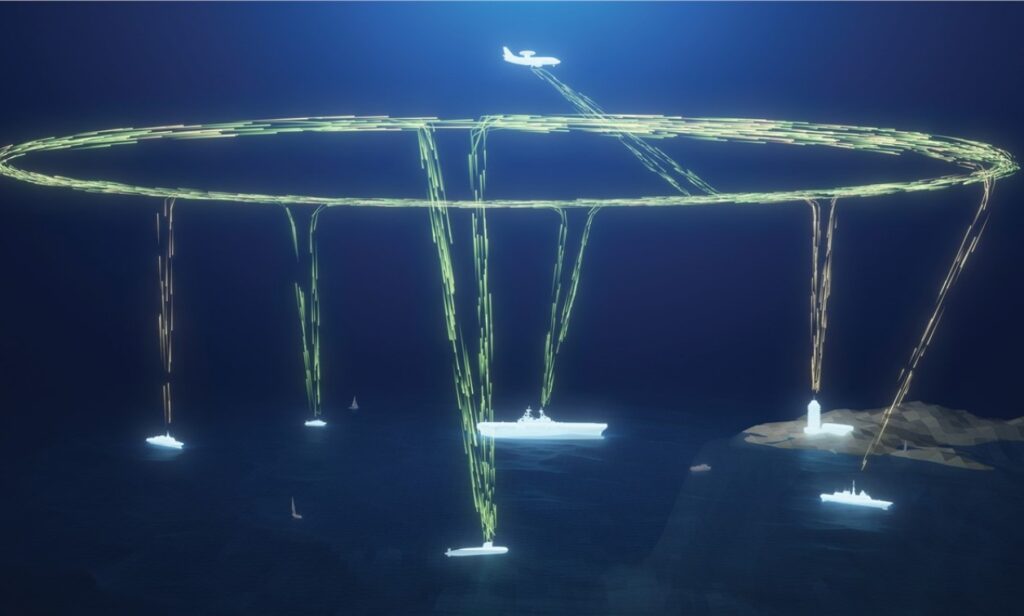Advancements in technology have changed the naval operating environment and requirements. Today, the success of the naval operation depends on establishing the recognized marine picture because of the rapid compilation of the information obtained from various sources of information and the sharing of this picture with the friendly forces in a secure way. Thanks to tactical data link systems (TDS) developments, naval platforms can fulfil many requirements of network-centric operations, such as target transfer and engagement orders.
TDL Systems have a critical role in fulfilling the information needs of different command levels in operations. TDL’s provide a means to disseminate information processed from RADAR, SONAR, Identification Friend or Foe (IFF), Electronic Warfare, Self-Reporting, and visual observation. Each TDL uses a data link standard to provide communications via radio waves or data cables. These military standards set the message standards for data link interoperability.
The United States had severe difficulties in tactical communication during the Vietnam War; Therefore, the need to develop faster, higher-capacity, and jam-resistant digital communication systems has emerged. New TDLs have been developed as a result of the studies that started in the 1970s. Link 11, Link 22, and Link 16 are the basic TDLs developed and under development.
Link 11
NATO has developed Link 11 TDL system to provide information sharing between surface platforms and air platforms. Although many countries worldwide still use it, the data transfer speed of Link 11 is slow. There are two types, Link 11 A and B. The second version of Link 11, Link 11B, has been developed to communicate land-based systems. Link 11B offers point-to-point data communication between two fixed stations. Link 11A is a network-based system. Link 11 is not seen as the link system of the future due to its use of single carrier frequency, weakness against electronic jamming, and a central node structure (the network becomes unusable with the destruction of a single critical unit).

Link 16
US improved Link 16 Joint Tactical Information Distribution (JTIDS) program capable of providing high-capacity data communication, resistance to electronic jamming, secure, supporting near real-time data transfer, and a nodeless structure for all platforms (air, surface, underwater, and land). The system can be used on land, air, surface, and underwater platforms and supports electronic warfare, ballistic missile defense, and many air operations.
Since communication between platforms does not occur over a fixed node in Link 16, communication is not affected by the damage or destruction of a particular platform. Transmissions are made over pre-assigned time slots to the platforms, so communication has a fluid structure. Link 16, which has been developed to meet the information exchange requirements of all tactical units, uses the J-series message catalogue that offers a broad data set. Link 16 supports the sharing of many important tactical data such as reconnaissance, surveillance, electronic warfare, mission assignment, weapon control, and coordination data exchange with friendly elements.
Although the system has been used by the USA and NATO for many years, it cannot be used entirely without problems. Problems such as the platforms ‘inability to transmit the requested information at the right time, to the right place, and the platforms’ failure to communicate with each other, some terminal-related problems are observed. Among the reasons for this situation, the standards are open to interpretation, system integrations and designs differ within and between countries, or the manufacturer company causes problems in terminal features. For this reason, countries using Link 16 meet regularly every year to discuss the issues they encounter and the developments planned to be made in Link 16.

Link 22
Link 22, also known as NATO Improved Link Eleven (NILE), is a communications standard for TDL’s. The new standard is planned to replace the widely used Link 11 in the medium term and will be employed concurrently with Link 16.
Link 22 is a secure TDL that operates in the HF and UHF bands by providing unprecedented situational awareness across the battlespace. The development of the system started in 1982 within the framework of the agreement of 6 NATO countries (Canada, France, Germany, Italy, Netherlands, England), including the USA, based on a memorandum of understanding (MoU). Deliveries to countries not belonging to the seven NILE nations will be governed by agreements with the NILE program management (NILE PMO). Link 22 is intended primarily by naval forces and is being progressively rolled out across navies.
It has been developed to securely exchange data between all the allied forces (air, ground, and sea). Link 22 supports both LOS and BLOS (Beyond Line of sight) communication links in the HF band up to distances of 300 nautical miles, which is still under development today, supports four basic waveforms: HF Fixed Frequency, HF EPM, UHF Fixed Frequency, and UHF EPM. As part of this development process, HF FF tests have been completed. UHF FF tests have been conducted other than the actual channel tests; However, HF EPM and UHF EPM tests were suspended due to technical problems and lack of consensus on various issues. Since it is still in the development phase, the integration process has not started fully.
Conclusion
TDL systems are the backbone of today’s network-centric warfare concept. For this reason, the success of the naval operation depends on the establishment of the recognized maritime picture and sharing this picture with all the elements. Protection of TDLs against all kinds of cyber and electronic threats is an essential element of operational safety.
Check out Naval Library App to find out the specifications of naval equipment.





